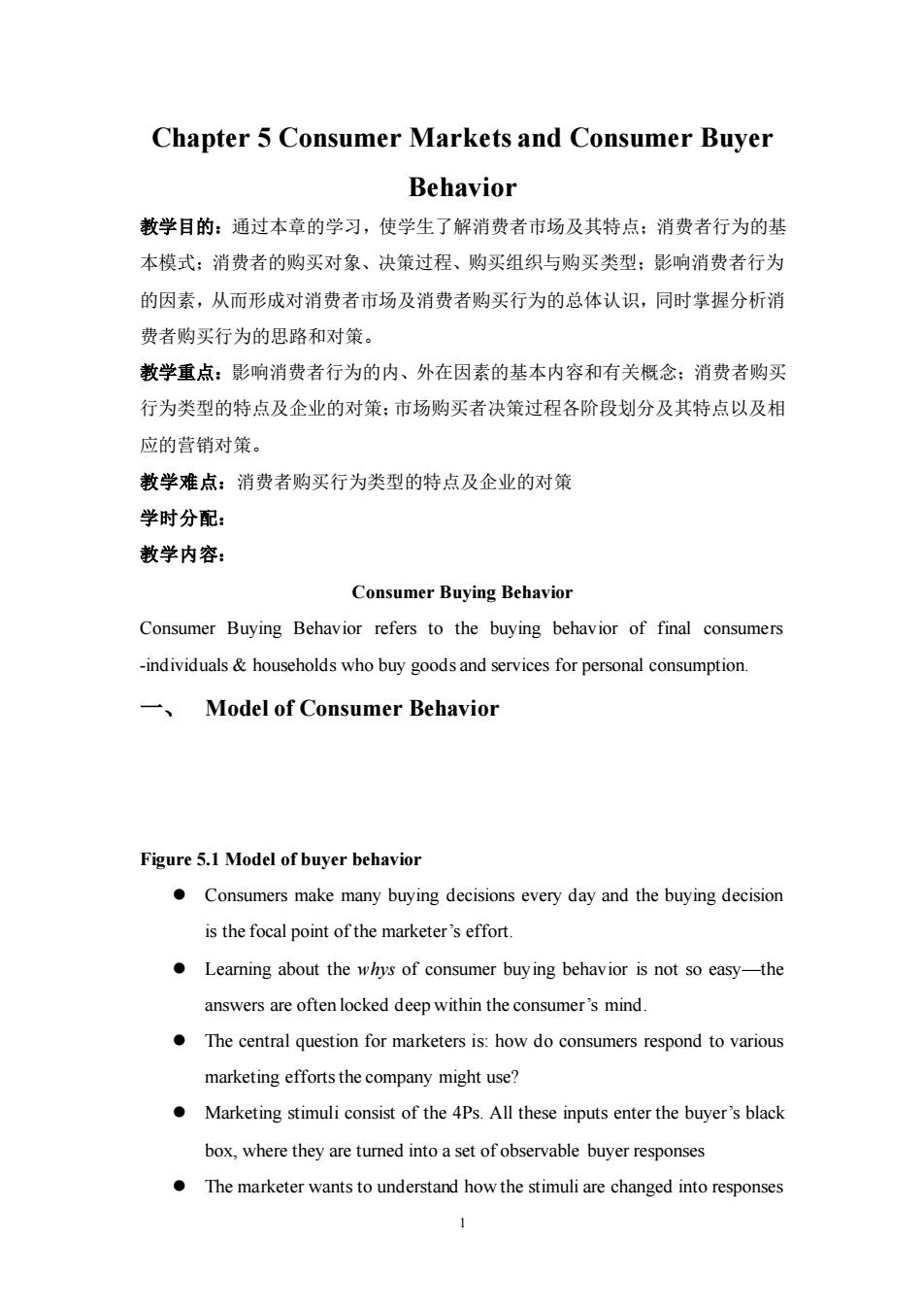
Chapter 5 Consumer Markets and Consumer Buyer Behavior 教学目的:通过本章的学习,使学生了解消费者市场及其特点:消费者行为的基 本模式:消费者的购买对象、决策过程、购买组织与购买类型:影响消费者行为 的因素,从而形成对消费者市场及消费者购买行为的总体认识,同时掌握分析消 费者购买行为的思路和对策。 教学重点:影响消费者行为的内、外在因素的基本内容和有关概念:消费者购买 行为类型的特点及企业的对策:市场购买者决策过程各阶段划分及其特点以及相 应的营销对策。 教学难点:消费者购买行为类型的特点及企业的对策 学时分配: 教学内容: Consumer Buying Behavior Consumer Buying Behavior refers to the buying behavior of final consumers -individuals&households who buy goods and services for personal consumption. 一、Model of Consumer Behavior Figure 5.1 Model of buyer behavior Consumers make many buying decisions every day and the buying decision is the focal point of the marketer's effort. Leamning about the whys of consumer buying behavior is not so easy-the answers are often locked deep within the consumer's mind. The central question for marketers is:how do consumers respond to various marketing efforts the company might use? Marketing stimuli consist of the 4Ps.All these inputs enter the buyer's black box,where they are tumed into a set of observable buyer responses The marketer wants to understand how the stimuli are changed into responses
1 Chapter 5 Consumer Markets and Consumer Buyer Behavior 教学目的:通过本章的学习,使学生了解消费者市场及其特点;消费者行为的基 本模式;消费者的购买对象、决策过程、购买组织与购买类型;影响消费者行为 的因素,从而形成对消费者市场及消费者购买行为的总体认识,同时掌握分析消 费者购买行为的思路和对策。 教学重点:影响消费者行为的内、外在因素的基本内容和有关概念;消费者购买 行为类型的特点及企业的对策;市场购买者决策过程各阶段划分及其特点以及相 应的营销对策。 教学难点:消费者购买行为类型的特点及企业的对策 学时分配: 教学内容: Consumer Buying Behavior Consumer Buying Behavior refers to the buying behavior of final consumers -individuals & households who buy goods and services for personal consumption. 一、 Model of Consumer Behavior Figure 5.1 Model of buyer behavior ⚫ Consumers make many buying decisions every day and the buying decision is the focal point of the marketer’s effort. ⚫ Learning about the whys of consumer buying behavior is not so easy—the answers are often locked deep within the consumer’s mind. ⚫ The central question for marketers is: how do consumers respond to various marketing efforts the company might use? ⚫ Marketing stimuli consist of the 4Ps. All these inputs enter the buyer’s black box, where they are turned into a set of observable buyer responses ⚫ The marketer wants to understand how the stimuli are changed into responses
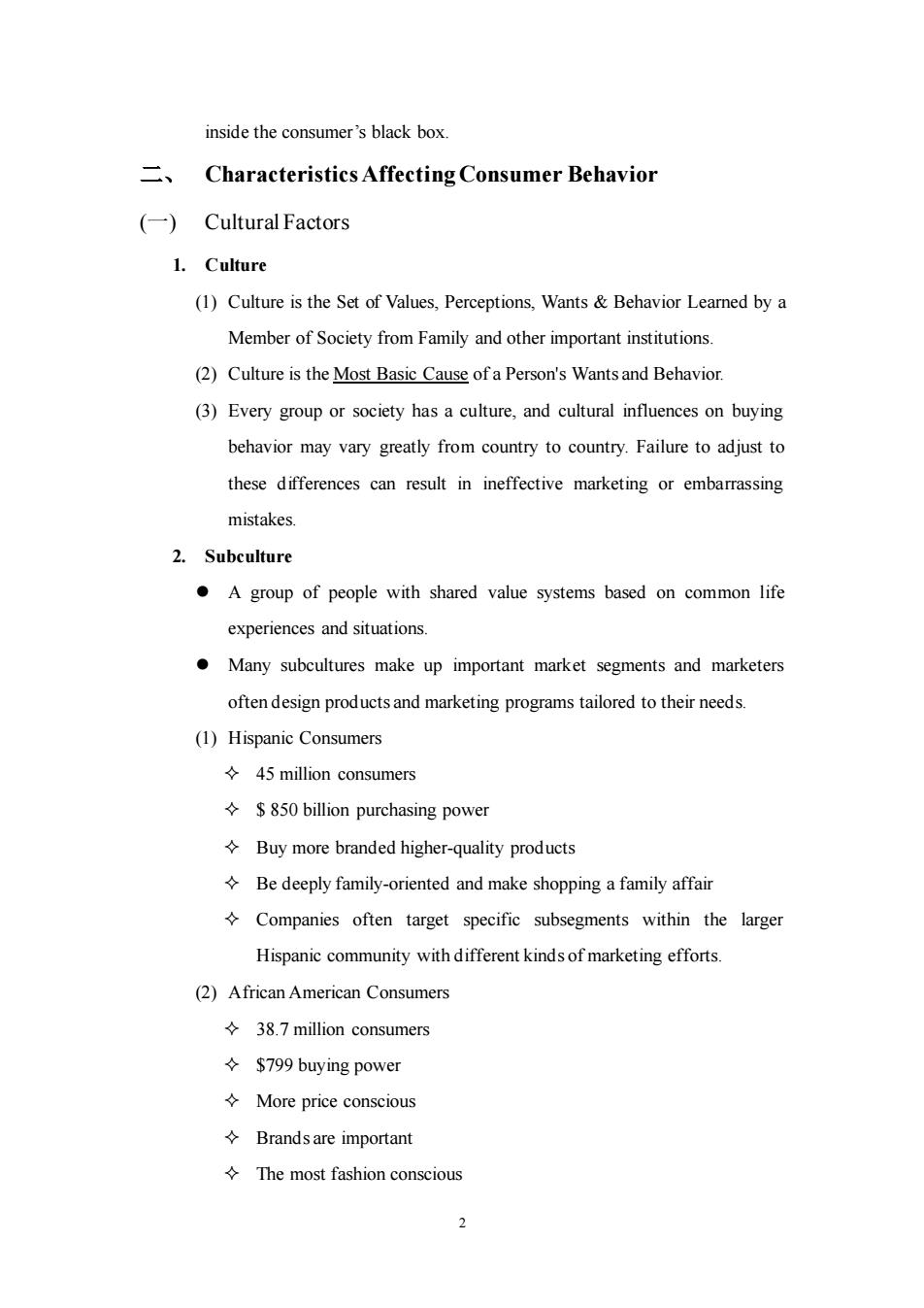
inside the consumer's black box. 二、 Characteristics Affecting Consumer Behavior ()Cultural Factors 1.Culture (1)Culture is the Set of Values,Perceptions,Wants&Behavior Learned by a Member of Society from Family and other important institutions (2)Culture is the Most Basic Cause of a Person's Wants and Behavior. (3)Every group or society has a culture,and cultural influences on buying behavior may vary greatly from country to country.Failure to adjust to these differences can result in ineffective marketing or embarrassing mistakes. 2.Subculture A group of people with shared value systems based on common life experiences and situations. Many subcultures make up important market segments and marketers often design products and marketing programs tailored to their needs. (1)Hispanic Consumers ◆45 million consumers $850 billion purchasing power Buy more branded higher-quality products Be deeply family-oriented and make shopping a family affair Companies often target specific subsegments within the larger Hispanic community with different kinds of marketing efforts. (2)African American Consumers 38.7 million consumers ◆$799 buying power ◇More price conscious ◇Brandsare important The most fashion conscious
2 inside the consumer’s black box. 二、 Characteristics Affecting Consumer Behavior (一) Cultural Factors 1. Culture (1) Culture is the Set of Values, Perceptions, Wants & Behavior Learned by a Member of Society from Family and other important institutions. (2) Culture is the Most Basic Cause of a Person's Wants and Behavior. (3) Every group or society has a culture, and cultural influences on buying behavior may vary greatly from country to country. Failure to adjust to these differences can result in ineffective marketing or embarrassing mistakes. 2. Subculture ⚫ A group of people with shared value systems based on common life experiences and situations. ⚫ Many subcultures make up important market segments and marketers often design products and marketing programs tailored to their needs. (1) Hispanic Consumers 45 million consumers $ 850 billion purchasing power Buy more branded higher-quality products Be deeply family-oriented and make shopping a family affair Companies often target specific subsegments within the larger Hispanic community with different kinds of marketing efforts. (2) African American Consumers 38.7 million consumers $799 buying power More price conscious Brands are important The most fashion conscious
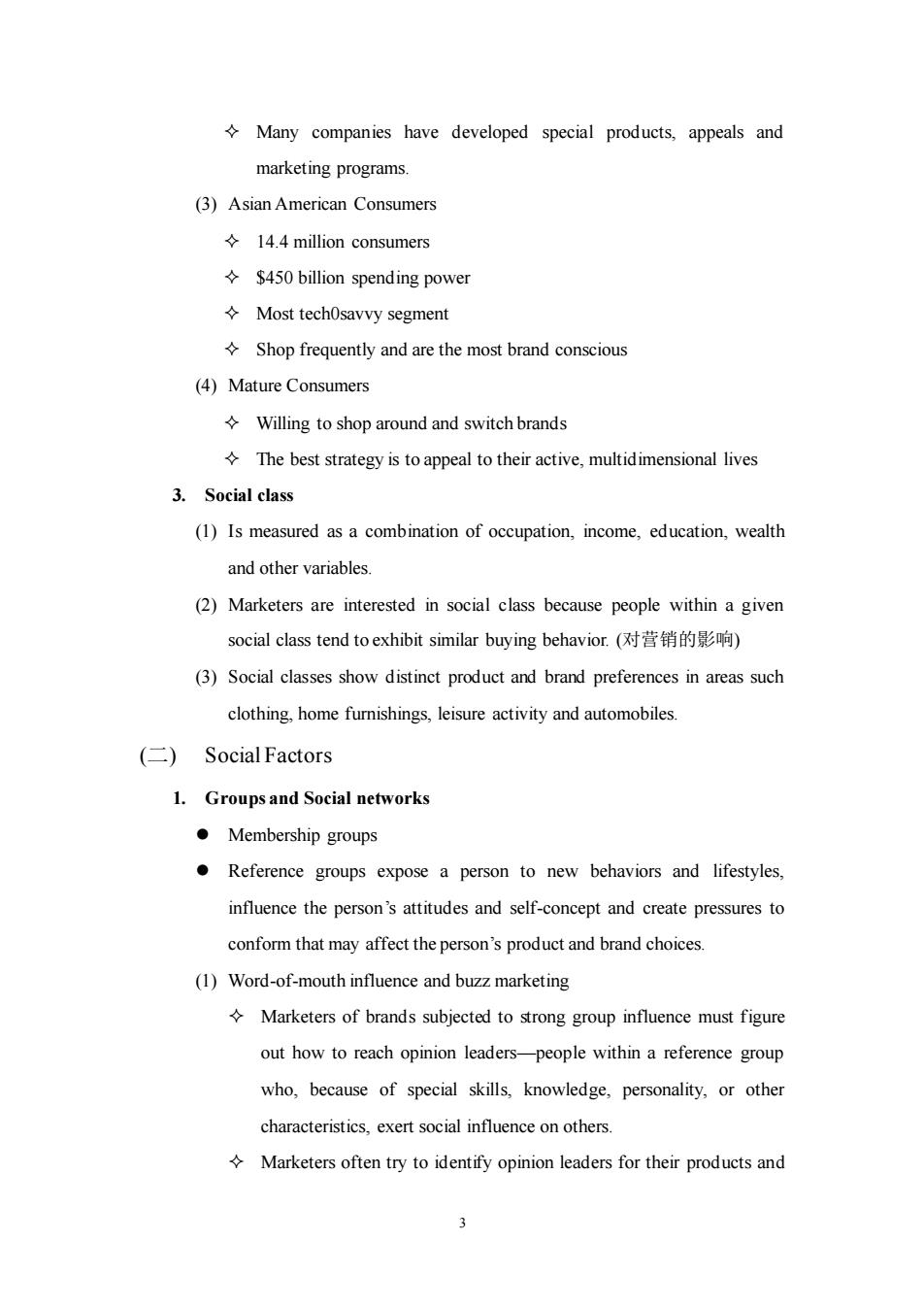
Many companies have developed special products,appeals and marketing programs. (3)AsianAmerican Consumers 14.4 million consumers $450 billion spending power Most techOsavvy segment Shop frequently and are the most brand conscious (4)Mature Consumers Willing to shop around and switch brands The best strategy is to appeal to their active,multidimensional lives 3.Social class (1)Is measured as a combination of occupation,income,education,wealth and other variables. (2)Marketers are interested in social class because people within a given social class tend toexhibit similar buying behavior.(对营销的影响) (3)Social classes show distinet product and brand preferences in areas such clothing,home furnishings,leisure activity and automobiles. (二)Social Factors 1.Groups and Social networks ◆Membership groups Reference groups expose a person to new behaviors and lifestyles. influence the person's attitudes and self-concept and create pressures to conform that may affect the person's product and brand choices. (1)Word-of-mouth influence and buzz marketing Marketers of brands subjected to strong group influence must figure out how to reach opinion leaders-people within a reference group who,because of special skills,knowledge,personality,or other characteristics,exert social influence on others Marketers often try to identify opinion leaders for their products and
3 Many companies have developed special products, appeals and marketing programs. (3) Asian American Consumers 14.4 million consumers $450 billion spending power Most tech0savvy segment Shop frequently and are the most brand conscious (4) Mature Consumers Willing to shop around and switch brands The best strategy is to appeal to their active, multidimensional lives 3. Social class (1) Is measured as a combination of occupation, income, education, wealth and other variables. (2) Marketers are interested in social class because people within a given social class tend to exhibit similar buying behavior. (对营销的影响) (3) Social classes show distinct product and brand preferences in areas such clothing, home furnishings, leisure activity and automobiles. (二) Social Factors 1. Groups and Social networks ⚫ Membership groups ⚫ Reference groups expose a person to new behaviors and lifestyles, influence the person’s attitudes and self-concept and create pressures to conform that may affect the person’s product and brand choices. (1) Word-of-mouth influence and buzz marketing Marketers of brands subjected to strong group influence must figure out how to reach opinion leaders—people within a reference group who, because of special skills, knowledge, personality, or other characteristics, exert social influence on others. Marketers often try to identify opinion leaders for their products and
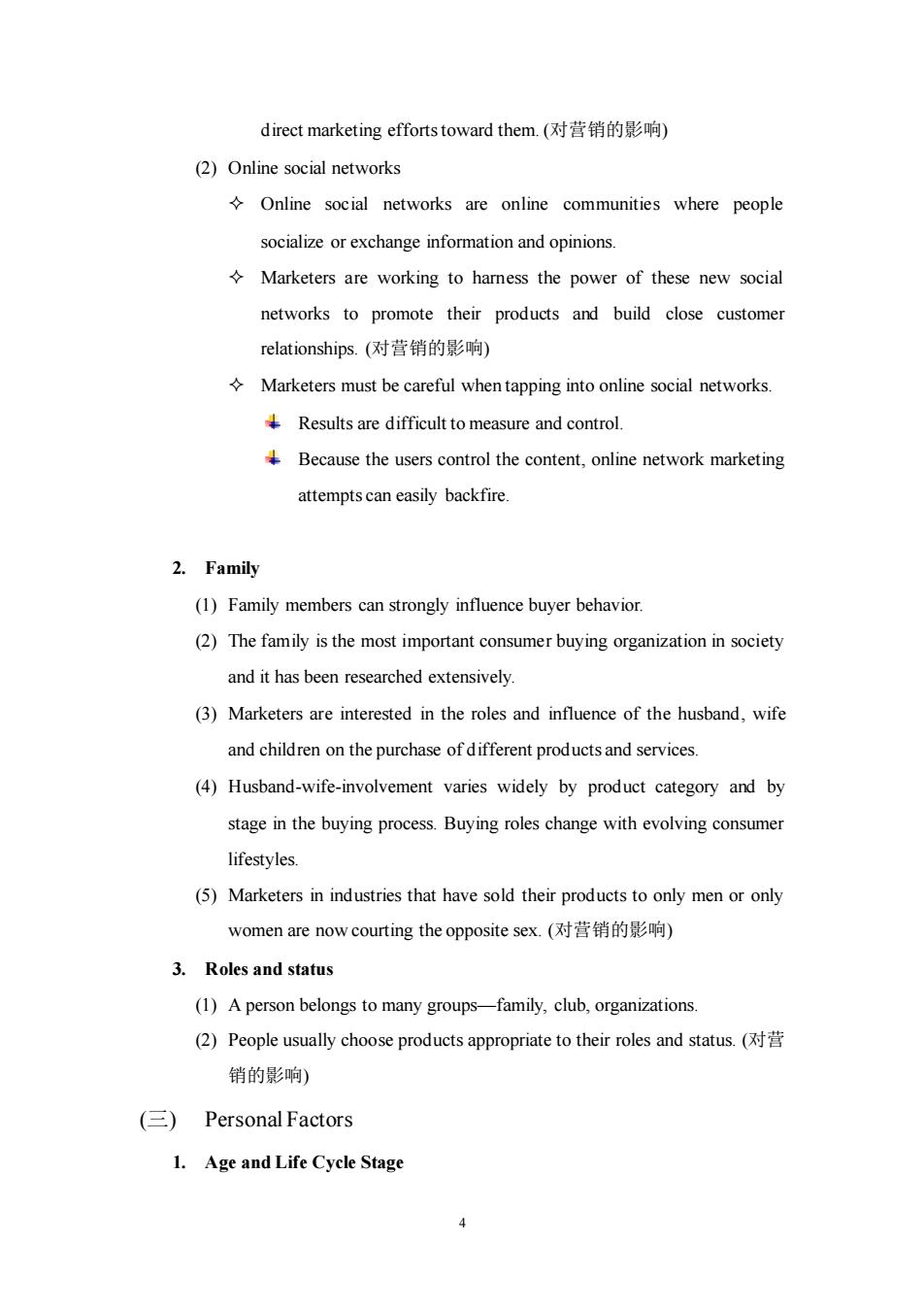
direct marketing efforts toward them.(对营销的影响) (2)Online social networks Online social networks are online communities where people socialize or exchange information and opinions. Marketers are working to hamess the power of these new social networks to promote their products and build close customer relationships.(对营销的影响) Marketers must be careful when tapping into online social networks. Results are difficult to measure and control. Because the users control the content,online network marketing attempts can easily backfire. 2.Family (1)Family members can strongly influence buyer behavior (2)The family is the most important consumer buying organization in society and it has been researched extensively. (3)Marketers are interested in the roles and influence of the husband,wife and children on the purchase of different products and services (4)Husband-wife-involvement varies widely by product category and by stage in the buying process.Buying roles change with evolving consumer lifestyles (5)Marketers in industries that have sold their products to only men or only women are now courting the opposite sex,.(对营销的影响) 3.Roles and status (1)A person belongs to many groups-family,club,organizations. (2)People usually choose products appropriate to their roles and status.( 销的影响) ()Personal Factors 1.Age and Life Cycle Stage
4 direct marketing efforts toward them. (对营销的影响) (2) Online social networks Online social networks are online communities where people socialize or exchange information and opinions. Marketers are working to harness the power of these new social networks to promote their products and build close customer relationships. (对营销的影响) Marketers must be careful when tapping into online social networks. Results are difficult to measure and control. Because the users control the content, online network marketing attempts can easily backfire. 2. Family (1) Family members can strongly influence buyer behavior. (2) The family is the most important consumer buying organization in society and it has been researched extensively. (3) Marketers are interested in the roles and influence of the husband, wife and children on the purchase of different products and services. (4) Husband-wife-involvement varies widely by product category and by stage in the buying process. Buying roles change with evolving consumer lifestyles. (5) Marketers in industries that have sold their products to only men or only women are now courting the opposite sex. (对营销的影响) 3. Roles and status (1) A person belongs to many groups—family, club, organizations. (2) People usually choose products appropriate to their roles and status. (对营 销的影响) (三) Personal Factors 1. Age and Life Cycle Stage
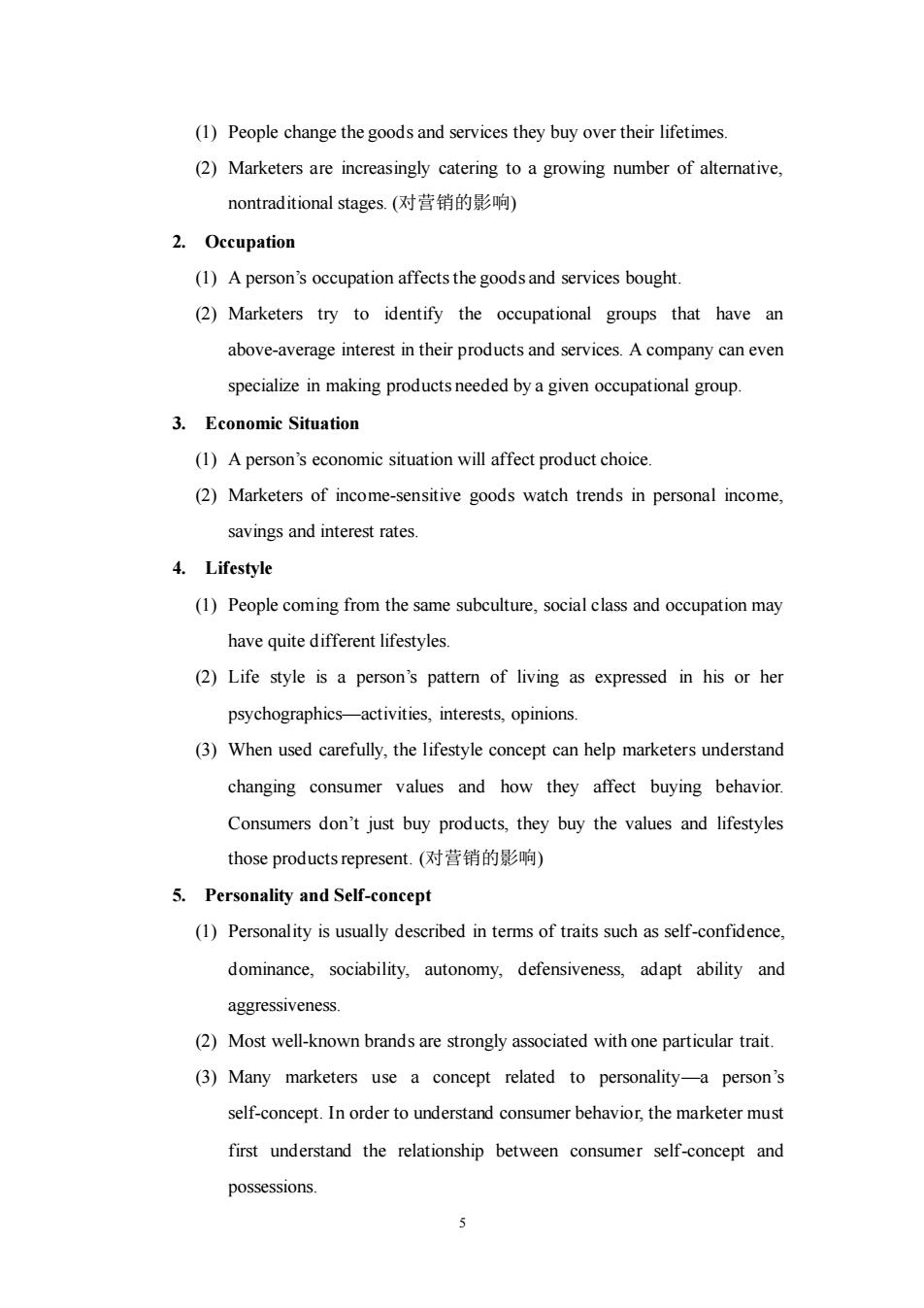
(1)People change the goods and services they buy over their lifetimes. (2)Marketers are increasingly catering to a growing number of altemative, nontraditional stages.(对营销的影响) 2.Occupation (1)A person's occupation affects the goods and services bought. (2)Marketers try to identify the occupational groups that have an above-average interest in their products and services.A company can even specialize in making products needed by a given occupational group. 3.Economic Situation (1)Aperson's economic situation will affect product choice (2)Marketers of income-sensitive goods watch trends in personal income, savings and interest rates. 4.Lifestyle (1)People coming from the same subculture,social class and occupation may have quite different lifestyles. (2)Life style is a person's pattern of living as expressed in his or her psychographics-activities,interests,opinions. (3)When used carefully,the lifestyle concept can help marketers understand changing consumer values and how they affect buying behavior. Consumers don't just buy products,they buy the values and lifestyles those products represent.(对营销的影响) 5.Personality and Self-concept (1)Personality is usually described in terms of traits such as self-confidence. dominance,sociability,autonomy,defensiveness,adapt ability and aggressiveness. (2)Most well-known brands are strongly associated with one particular trait. (3)Many marketers use a concept related to personality-a person's self-concept.In order to understand consumer behavior,the marketer must first understand the relationship between consumer self-concept and possessions
5 (1) People change the goods and services they buy over their lifetimes. (2) Marketers are increasingly catering to a growing number of alternative, nontraditional stages. (对营销的影响) 2. Occupation (1) A person’s occupation affects the goods and services bought. (2) Marketers try to identify the occupational groups that have an above-average interest in their products and services. A company can even specialize in making products needed by a given occupational group. 3. Economic Situation (1) A person’s economic situation will affect product choice. (2) Marketers of income-sensitive goods watch trends in personal income, savings and interest rates. 4. Lifestyle (1) People coming from the same subculture, social class and occupation may have quite different lifestyles. (2) Life style is a person’s pattern of living as expressed in his or her psychographics—activities, interests, opinions. (3) When used carefully, the lifestyle concept can help marketers understand changing consumer values and how they affect buying behavior. Consumers don’t just buy products, they buy the values and lifestyles those products represent. (对营销的影响) 5. Personality and Self-concept (1) Personality is usually described in terms of traits such as self-confidence, dominance, sociability, autonomy, defensiveness, adapt ability and aggressiveness. (2) Most well-known brands are strongly associated with one particular trait. (3) Many marketers use a concept related to personality—a person’s self-concept. In order to understand consumer behavior, the marketer must first understand the relationship between consumer self-concept and possessions